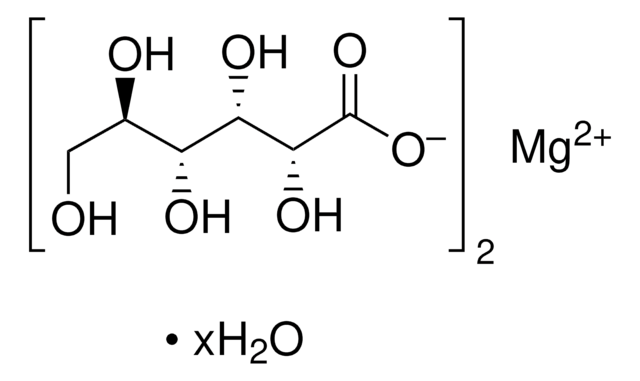08114
Magnesium L-pidolate
98.0-102.0% (calc. on dry substance, T)
Synonim(y):
MAG2, Magnesium (S)-2-pyrrolidone-5-carboxylate, Magnesium 5-oxo-L-proline
About This Item
Polecane produkty
Próba
98.0-102.0% (calc. on dry substance, T)
aktywność optyczna
[α]/D -24±1.5°, c = 0.5 in H2O
pH
5.5-7.5 (25 °C, 50 mg/mL in H2O)
rozpuszczalność
H2O: 50 mg/mL, clear, colorless
ślady anionów
chloride (Cl-): ≤500 mg/kg
nitrate (NO3-): ≤50 mg/kg
phosphate (PO43-): ≤50 mg/kg
sulfate (SO42-): ≤200 mg/kg
ślady kationów
Ag: ≤5 mg/kg
Al: ≤5 mg/kg
As: ≤0.5 mg/kg
Ba: ≤5 mg/kg
Be: ≤5 mg/kg
Bi: ≤5 mg/kg
Ca: ≤50 mg/kg
Cd: ≤5 mg/kg
Co: ≤5 mg/kg
Cr: ≤5 mg/kg
Cu: ≤5 mg/kg
Fe: ≤5 mg/kg
K: ≤10 mg/kg
Li: ≤5 mg/kg
Mn: ≤5 mg/kg
Mo: ≤5 mg/kg
Na: ≤50 mg/kg
Ni: ≤5 mg/kg
Pb: ≤5 mg/kg
Sr: ≤5 mg/kg
Ti: ≤5 mg/kg
Zn: ≤5 mg/kg
Zr: ≤5 mg/kg
ciąg SMILES
O=C1CC[C@H](N1)C(=O)O[Mg]OC(=O)[C@@H]2CCC(=O)N2
InChI
1S/2C5H7NO3.Mg/c2*7-4-2-1-3(6-4)5(8)9;/h2*3H,1-2H2,(H,6,7)(H,8,9);/q;;+2/p-2/t2*3-;/m00./s1
Klucz InChI
JQAACYUZYRBHGG-QHTZZOMLSA-L
Zastosowanie
Kod klasy składowania
11 - Combustible Solids
Klasa zagrożenia wodnego (WGK)
WGK 3
Temperatura zapłonu (°F)
Not applicable
Temperatura zapłonu (°C)
Not applicable
Środki ochrony indywidualnej
Eyeshields, Gloves, type N95 (US)
Certyfikaty analizy (CoA)
Poszukaj Certyfikaty analizy (CoA), wpisując numer partii/serii produktów. Numery serii i partii można znaleźć na etykiecie produktu po słowach „seria” lub „partia”.
Masz już ten produkt?
Dokumenty związane z niedawno zakupionymi produktami zostały zamieszczone w Bibliotece dokumentów.
Klienci oglądali również te produkty
Nasz zespół naukowców ma doświadczenie we wszystkich obszarach badań, w tym w naukach przyrodniczych, materiałoznawstwie, syntezie chemicznej, chromatografii, analityce i wielu innych dziedzinach.
Skontaktuj się z zespołem ds. pomocy technicznej










